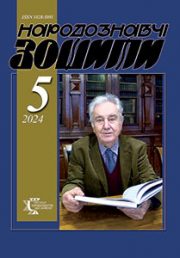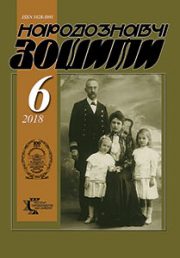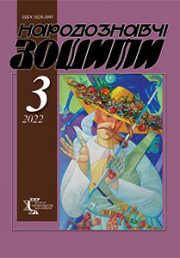The Ethnology Notebooks. 2020. № 1 (151), 147—154
UDK75.052(477.43/44)”20″
DOI https://doi.org/10.15407/nz2020.01.147
PODILLIA’S DOMESTIC MURAL PAINTING WITHIN MODERN ARTISTIC PRACTICES
STUDENETS Natalia
ORCID ID: http://orcid.org/0000-0003-4314-6475
Ph.D. in Art Studies,
Senior Researcher,
Rylskyi Art Studies, Folkloristics
and Ethnology, NAS of Ukraine
Fine Art & Decorative and Applied Art Department
4, Hrushevskyi St., 01001, Kyiv, Ukraine,
Contacts: e-mail: studenez@ukr.net
Abstract. In the globalized space of mass culture, the ethnic component indispensable for preserving national identity and originality is of particular importance in social activities. The topicality of the theme is called forth by the need to consider the processes of restoring traditional artistic practices in the system of folk culture in Podillia. The purpose of the submitted study is both to find out the specificity and to analyse artistic features of the modern Podillia mural painting in its various forms. The object of the study is wall paintings of the early 21st century, created in separate centres of the region, while the investigation’s subject is reflections of traditional features and latest trends in the paintings. The main research methods are axiological for revealing the value features of modern mural paintings; art critical analysis for describing auctorial styles in the works; as well as the interviewing method for exposing supplemental information related to the research issue.
The article analyses peculiarities of holding the International Symposia The Painting Hut (over 2012—2019), which were attended by professional and amateur painters from Ukraine, Poland, Moldova, as well as residents of villages. It also investigates artists’ creative search for trends, stylistics, and plastic solutions in modern mural painting. Distinguished are the most expressive examples, which are characterized by imitation and interpretation of authentic traditions of painting, stylistics of folk pictures, as well as European ideas of Postmodernism. The authoress considers original author’s conceptions of wall painting in separate centres of the Podillia region.
It is ascertained that domestic mural painting of the early 21st century is a multifaceted phenomenon, which usually develops in the general artistic context and appropriately reflects the trends inherent in modern visual arts.
Keywords: domestic mural painting, tradition, Podillia, modern artistic practices, artists.
Received 3.01.2020
REFERENCES
Kryzhanivskyi, Mykola. (2018). The Painted Hut: An International Artistic and Culturological Project in 2012—2018. Vinnytsia: Konsol [in Ukrainian].
Panchuk, Fedir. (2012). My White Painted Hut. The Chamber, 4 (39), 60—63 [in Ukrainian].
Dmytrenko, Zhanna. (2014). The Painted Hut. The Chamber, 3 (46), 41—43 [in Ukrainian].
Kryzhanivskyi, Mykola. (2018). The Painted Hut. The Chamber, 2 (61), 45—47 [in Ukrainian].
Bukatynka: An Area of Love and Freedom. Part I. Retrieved from: https://zalgalina.livejournal.com/110992.html [in Russain].
Bukatynka. A Living Museum in the Abandoned Houses. Retrieved from: https://ukrainer.net/bukatinka/ [in Russian].
A Vinnytsia Female Artist Turned an Abandoned House into an Art Object. Retrieved from: http://vlasno.info/spetsproekti/1/persona/item/7293-iuliia-gushul [in Ukrainian].
A Small Village Has Become a Cultural Tourist Space [on line]. Retrieved from: https://day.kyiv.ua/uk/article/podorozhi/malenke-selo-stalo-kulturnym-turystychnym-prostorom.
Studenets, Natalia. (2018). Ukrainian Domestic Mural Painting in Context of Modern Creative Search. In: Traditional Culture in the Context of Globalization: Authenticity Preservation and Advance of Creative Industries. Proceedings of the 22—23 June 2018. Theoretical and Practical Conference (Pp. 388—390). Kharkiv: Madrid Printing House [in Ukrainian].
Studenets, Natalia. (2019). Synergy of the Domestic Mural Painting Tradition in Modern Artistic Practices in Podillia. In: Traditional Culture in the Context of Globalization: Synergy of Tradition and Innovation. Proceedings of the 21—22 June 2019. Theoretical and Practical Conference (Pp. 322—324). Kharkiv: Madryd Printing House [in Ukrainian].
Lotman, Yuriy. (1992). Articles on Semiotics and Typology of Culture. Selected Articles: 3 vol. (Vol. 1). Tallinn: Aleksandra [in Russian].
Nayden, Oleksandr. (2018). Ukrainian Folk Paintings. Poetic Manner, Semantics, and Cosmology. Kyiv: Stylus [in Ukrainian].






